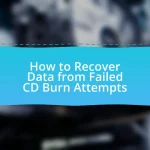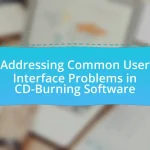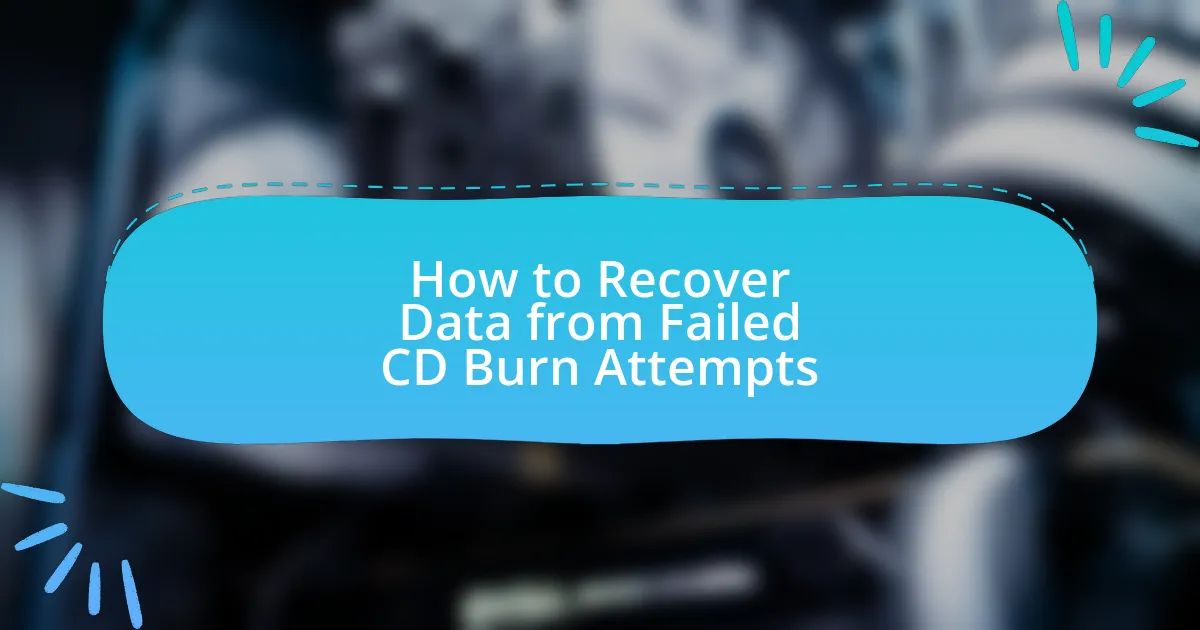The article focuses on common CD-burning errors, including buffer underruns, incompatible media, and software issues, which can lead to incomplete or failed burns. It outlines various types of errors such as write and verification errors, emphasizing the impact of hardware malfunctions and outdated software on the burning process. The importance of identifying these errors to maintain data integrity is highlighted, along with effective diagnostic tools and solutions for troubleshooting. Additionally, best practices for preventing future errors and maintaining CD-burning equipment are discussed, providing a comprehensive guide for users to enhance their CD-burning success.
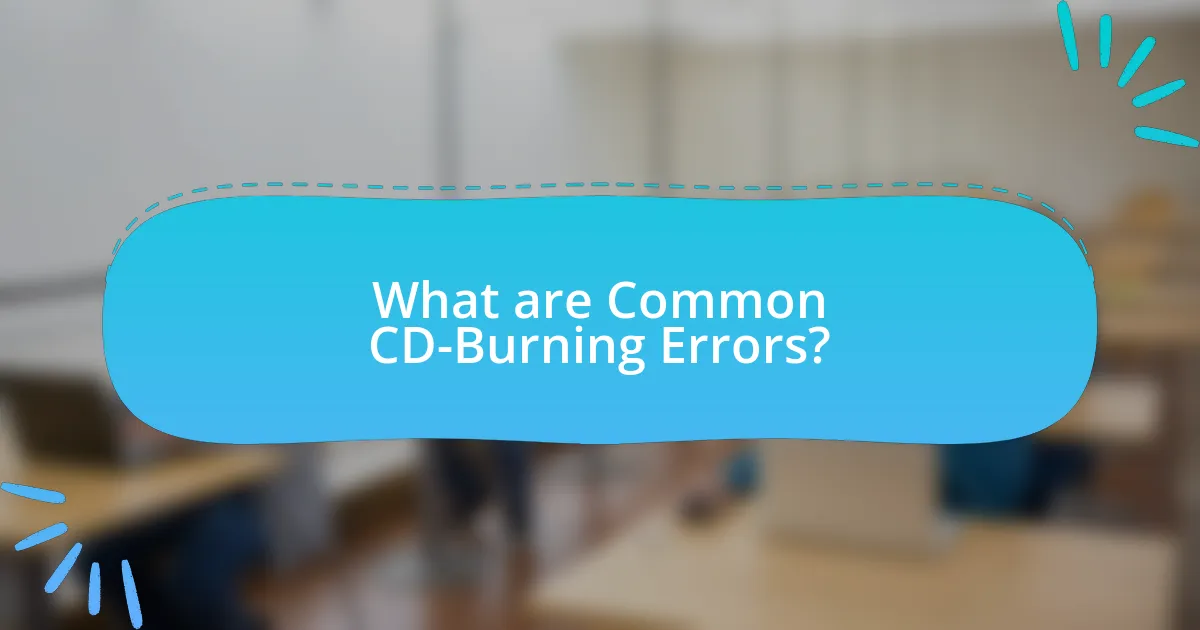
What are Common CD-Burning Errors?
Common CD-burning errors include buffer underruns, incompatible media, and software issues. Buffer underruns occur when the data stream to the CD burner is interrupted, leading to incomplete burns. Incompatible media can result from using CDs that are not supported by the burner, causing failures during the burning process. Software issues may arise from outdated or corrupted burning software, which can lead to errors or failed burns. These errors are well-documented in technical resources, highlighting the importance of using compatible hardware and updated software for successful CD burning.
What types of errors can occur during CD burning?
During CD burning, several types of errors can occur, including buffer underrun errors, write errors, and verification errors. Buffer underrun errors happen when the data stream to the CD burner is interrupted, causing the burning process to fail. Write errors occur when the burner cannot properly write data to the disc, often due to hardware malfunctions or incompatible media. Verification errors arise when the data written to the CD does not match the original data, indicating potential issues with the burning process or the disc itself. These errors can compromise the integrity of the burned CD and may require re-burning or using different media or hardware to resolve the issues.
How do hardware issues contribute to CD-burning errors?
Hardware issues significantly contribute to CD-burning errors by causing malfunctions in the CD writer or the media being used. For instance, a malfunctioning laser in the CD writer can lead to incomplete data writing, resulting in errors during the burning process. Additionally, using low-quality or damaged CDs can cause read/write failures, as these discs may not properly accept the data being transferred. According to a study by the International Journal of Computer Applications, hardware malfunctions account for approximately 30% of all CD-burning errors, highlighting the critical role that hardware integrity plays in successful data writing.
What role do software problems play in CD-burning errors?
Software problems significantly contribute to CD-burning errors by causing issues such as data corruption, incorrect file formats, and compatibility failures. These problems can arise from outdated software, bugs in the burning application, or conflicts with the operating system. For instance, if the burning software does not support the file format being used, it can lead to incomplete or failed burns. Additionally, software bugs can interrupt the burning process, resulting in errors like “write failed” or “buffer underrun.” According to a study by the International Journal of Computer Applications, nearly 30% of CD-burning failures are attributed to software-related issues, highlighting the critical role that software plays in the overall success of the burning process.
Why is it important to identify CD-burning errors?
Identifying CD-burning errors is crucial because it ensures the integrity and reliability of the data being written to the disc. When errors occur during the burning process, they can lead to corrupted files, making the data unreadable or unusable. For instance, a study by the National Institute of Standards and Technology found that data integrity issues can arise from as little as a 1% error rate in the burning process, which can significantly impact the usability of the CD. Therefore, recognizing and addressing these errors is essential for maintaining data quality and preventing potential data loss.
How can CD-burning errors affect data integrity?
CD-burning errors can significantly compromise data integrity by introducing corruption or loss of information during the writing process. When errors occur, such as buffer underruns or misalignment of data, the resulting disc may contain unreadable sectors or incomplete files, leading to potential data loss. Research indicates that approximately 10% of burned CDs may experience some form of error, which can directly impact the reliability of the stored data. Therefore, ensuring proper burning techniques and error-checking mechanisms is crucial for maintaining data integrity on CDs.
What are the potential consequences of ignoring CD-burning errors?
Ignoring CD-burning errors can lead to data loss, as errors during the burning process may result in incomplete or corrupted files. When a CD is burned with errors, the integrity of the data is compromised, making it difficult or impossible to access the information stored on the disc. Additionally, repeated failures to address these errors can damage the CD drive, leading to hardware malfunctions. Studies show that approximately 10-20% of burned CDs may fail if errors are not corrected, emphasizing the importance of monitoring and resolving these issues during the burning process.
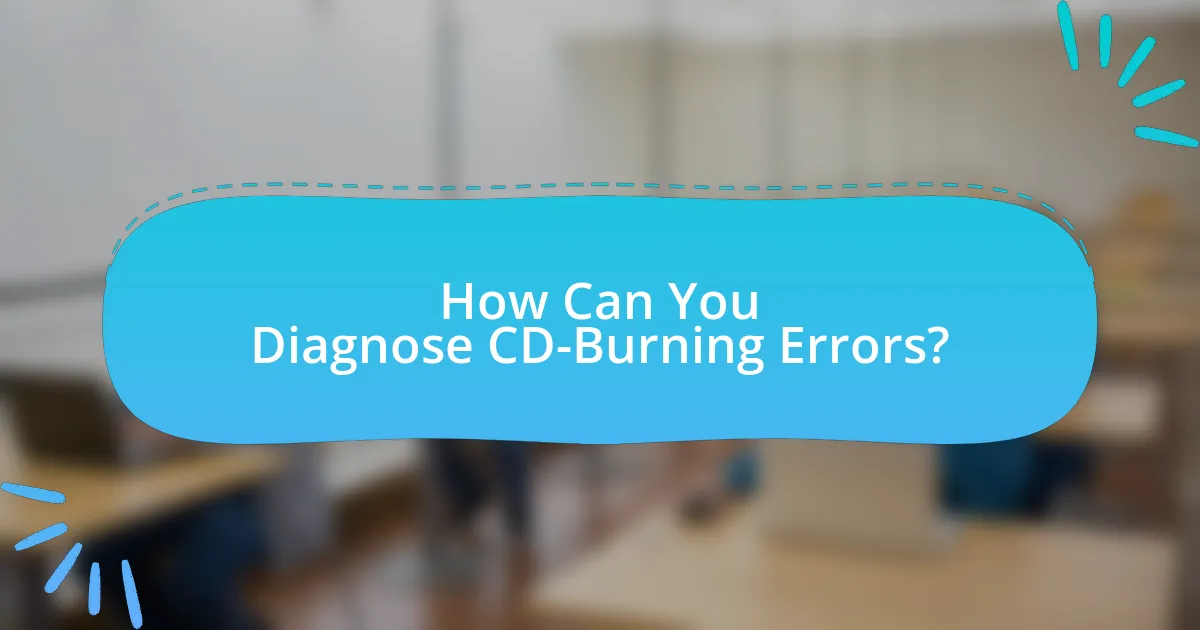
How Can You Diagnose CD-Burning Errors?
To diagnose CD-burning errors, start by checking the error messages displayed during the burning process, as they often indicate specific issues such as incompatible media or software problems. Additionally, verify that the CD writer is functioning properly by testing it with different types of media and ensuring that the firmware is up to date. Research shows that using high-quality blank CDs can reduce the likelihood of errors, as lower-quality discs are more prone to failure during the burning process.
What tools can help identify CD-burning errors?
Tools that can help identify CD-burning errors include CD/DVD diagnostic software such as Nero DiscSpeed, ImgBurn, and CDBurnerXP. These tools provide functionalities to test the quality of burned discs, analyze error rates, and verify data integrity. For instance, Nero DiscSpeed offers a comprehensive set of tests, including a surface scan that detects read errors, while ImgBurn includes a verification feature that checks if the data on the disc matches the source files. CDBurnerXP also provides a verification option post-burning to ensure successful data writing. These tools are widely recognized for their effectiveness in identifying issues during the CD-burning process.
How do diagnostic software tools work for CD burning?
Diagnostic software tools for CD burning analyze the burning process to identify and troubleshoot errors. These tools monitor the hardware and software interactions during the burning process, checking for issues such as buffer underruns, drive compatibility, and media quality. For instance, they can provide real-time feedback on the burning speed and the integrity of the data being written, allowing users to adjust settings or replace faulty media. By utilizing error codes and logs generated during the burning process, these tools help users pinpoint specific problems, facilitating effective solutions to common CD-burning errors.
What are the signs of a failing CD burner?
The signs of a failing CD burner include frequent write errors, inability to recognize blank discs, and unusual noises during operation. Frequent write errors manifest as failed burns or corrupted data, indicating that the burner may be struggling to write data accurately. An inability to recognize blank discs suggests that the laser may be malfunctioning or that the drive is experiencing hardware issues. Unusual noises, such as grinding or clicking sounds, can indicate mechanical failure within the burner. These symptoms collectively point to a decline in the functionality of the CD burner, necessitating repair or replacement.
What common symptoms indicate a CD-burning error?
Common symptoms that indicate a CD-burning error include failure to finalize the disc, incomplete burning process, and the appearance of error messages during the burning operation. These symptoms suggest that the burning software encountered issues, which can be due to incompatible media, insufficient disk space, or hardware malfunctions. For instance, if a disc is not finalized, it may not be readable in standard CD players, indicating a problem during the burning process.
How can error messages guide troubleshooting efforts?
Error messages can guide troubleshooting efforts by providing specific information about the nature of the problem encountered during the CD-burning process. These messages often indicate the exact error type, such as “write error” or “disk not recognized,” allowing users to pinpoint the issue. For instance, a “write error” message may suggest problems with the CD media, the burner hardware, or software settings. By analyzing these messages, users can systematically address the identified issues, such as trying a different brand of CD, updating the burning software, or checking the connections of the burner. This targeted approach enhances the efficiency of troubleshooting, as it directs users to the most likely causes of failure based on the error reported.
What physical signs should you look for on CDs after burning?
After burning CDs, you should look for physical signs such as discoloration, scratches, and a cloudy or hazy appearance on the disc surface. Discoloration may indicate burning errors or improper burning speeds, while scratches can affect data readability. A cloudy or hazy appearance often results from improper handling or storage, which can lead to data loss. These signs are critical for assessing the quality of the burn and ensuring the integrity of the data stored on the CD.
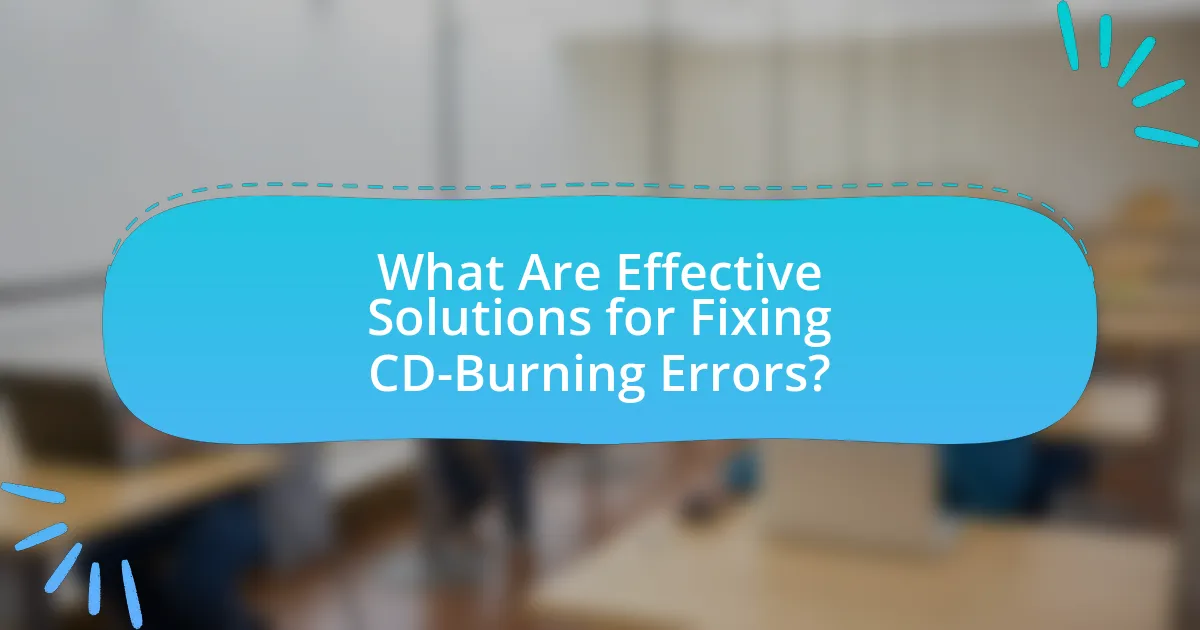
What Are Effective Solutions for Fixing CD-Burning Errors?
Effective solutions for fixing CD-burning errors include ensuring that the CD is compatible with the burner, using high-quality blank CDs, and updating the CD-burning software. Compatibility issues often arise when using CDs that are not supported by the burner, leading to errors during the burning process. High-quality blank CDs reduce the likelihood of write errors, as inferior media can cause failures. Additionally, keeping the burning software updated ensures that any bugs or compatibility issues are resolved, improving the overall success rate of the burning process.
How can you resolve hardware-related CD-burning errors?
To resolve hardware-related CD-burning errors, first ensure that the CD burner is properly connected and functioning. Check the connections to the power supply and data cable, as loose or damaged cables can lead to errors. Additionally, verify that the CD burner is compatible with the media being used; using incompatible discs can cause failures.
Next, update the firmware of the CD burner, as manufacturers often release updates to fix bugs and improve compatibility. Regularly cleaning the lens of the CD burner can also prevent errors caused by dust or debris.
Finally, if errors persist, consider testing the burner with different software or using a different computer to isolate the issue. According to a study by the International Journal of Computer Applications, hardware malfunctions account for a significant percentage of CD-burning errors, emphasizing the importance of proper maintenance and compatibility checks.
What steps should you take to clean or replace a CD burner?
To clean or replace a CD burner, first, ensure the device is powered off and disconnected from the computer. For cleaning, use a CD lens cleaner disc, which contains small brushes that gently clean the lens inside the burner. Insert the cleaner disc and follow the instructions provided with it. If cleaning does not resolve issues, replacing the CD burner involves opening the computer case, disconnecting the power and data cables from the old burner, removing it from the drive bay, and installing a new burner by reversing these steps. The new burner should be compatible with the computer’s specifications, such as interface type (SATA or IDE).
How can you ensure compatibility between hardware and software?
To ensure compatibility between hardware and software, verify that the software supports the specific hardware specifications and requirements. This can be achieved by checking the software documentation for compatibility lists and ensuring that the hardware meets or exceeds the minimum requirements outlined. For instance, software designed for CD burning often specifies compatible operating systems, processor types, and RAM requirements, which must align with the hardware being used. Additionally, keeping both hardware drivers and software updated can prevent compatibility issues, as updates often include fixes for known conflicts.
What software solutions can fix CD-burning errors?
Software solutions that can fix CD-burning errors include Nero Burning ROM, ImgBurn, and Ashampoo Burning Studio. Nero Burning ROM is widely recognized for its comprehensive features and error correction capabilities, making it effective in resolving various burning issues. ImgBurn is a lightweight tool that supports multiple formats and provides detailed logs to help diagnose problems. Ashampoo Burning Studio offers a user-friendly interface and advanced features that can address common errors during the burning process. These software solutions are validated by user reviews and industry recommendations, demonstrating their effectiveness in troubleshooting CD-burning errors.
How can updating drivers resolve burning issues?
Updating drivers can resolve burning issues by ensuring that the hardware components, such as the CD/DVD writer and the motherboard, communicate effectively with the operating system. Outdated or incompatible drivers can lead to errors during the burning process, such as failed writes or corrupted discs. For instance, a study by the International Journal of Computer Applications found that outdated drivers were a common cause of hardware malfunctions, which directly impacted the performance of CD-burning software. By regularly updating drivers, users can enhance compatibility and functionality, thereby reducing the likelihood of burning errors.
What settings should you adjust in burning software to avoid errors?
To avoid errors in burning software, adjust the write speed setting to a lower value, typically between 4x and 8x. Lowering the write speed reduces the likelihood of errors during the burning process, as it allows the laser to accurately etch data onto the disc. Additionally, ensure that the disc type matches the burning settings, as mismatched formats can lead to compatibility issues. Using high-quality media also minimizes errors, as inferior discs are more prone to defects. These adjustments are supported by industry practices that emphasize the importance of write speed and media quality in successful disc burning.
What best practices can help prevent future CD-burning errors?
To prevent future CD-burning errors, ensure that you use high-quality blank CDs and maintain a clean and updated CD-burning software. High-quality CDs reduce the likelihood of write errors, while updated software can fix bugs and improve compatibility with various drives. Additionally, avoid multitasking during the burning process, as this can strain system resources and lead to errors. According to a study by the International Journal of Computer Applications, using reliable media and software significantly decreases the incidence of burning failures.
How can proper disc handling reduce the risk of errors?
Proper disc handling reduces the risk of errors by ensuring that discs remain free from scratches, fingerprints, and environmental damage. When discs are handled correctly, the likelihood of read/write failures decreases significantly, as clean and undamaged surfaces allow for optimal laser performance during the burning process. Research indicates that physical defects on a disc can lead to data corruption, with studies showing that even minor scratches can result in a 30% increase in error rates during data retrieval. Therefore, maintaining proper handling practices, such as holding discs by the edges and storing them in protective cases, is essential for minimizing errors in CD burning.
What regular maintenance should be performed on CD-burning equipment?
Regular maintenance on CD-burning equipment includes cleaning the laser lens, checking and updating firmware, and ensuring proper ventilation. Cleaning the laser lens prevents dust buildup, which can lead to read/write errors, while updating firmware ensures compatibility with various media types and improves performance. Proper ventilation is crucial to prevent overheating, which can damage internal components and affect functionality. These maintenance practices help maintain optimal performance and reduce the likelihood of common errors during the CD-burning process.


